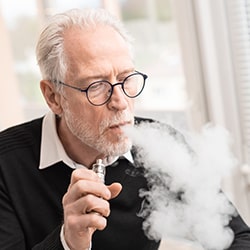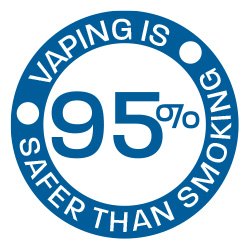Frequently Asked Questions
Are e-cigarettes safe to use?
All lithium batteries have the potential to fail. That includes mobile phones, tablets and vape devices. Fortunately, the risk of a modern lithium battery causing serious damage is rare. It is also far safer than smoking. In fact, the London Fire Service urges smokers to consider vaping, stating:
“Hundreds of people are injured in smoking related fires each year but we’ve not had any reports of injuries or deaths caused by e-cigarettes.”
It is still important to take care in order to minimise risk. Steps you can take include:
- Always use an approved charger
- Always buy from a reputable source
- Charge on a hard surface
- Monitor the device while charging
- Do not store with metal
- Do not expose to heat, sun or water
- Keep battery terminals clean

Do I vape like I would smoke?
Using an e-cigarette is different to smoking a cigarette. This usually involves taking slower and longer puffs over a longer period of time; this is because e-cigarettes heat a coil in a liquid (think of a kettle).
You may feel the need to take a few puffs on an e-cigarette at times when you would not have smoked; this is nothing to worry about and your pattern of e-cigarette use will develop over time.
Will I end up having more nicotine because I am vaping?
When you smoke a cigarette, you tend to finish it – even if you have had enough. In contrast, vaping is designed to be used as little or as often as you wish. This means that vapers use their devices more often – but taking in less nicotine at any one time.
Just as with cigarettes, you soon learn how much nicotine you need. If you ever do have a little too much, you will feel lightheaded, and will not want to vape more. There have been no cases of overdosing from using too much e-liquid.
What is in e-liquid?
Only four ingredients are used in e-liquid:
- Propylene glycol
- vegetable glycerine
- pharmaceutical grade nicotine
- flavourings.
In the UK, potentially harmful ingredients are banned from being used, and the ingredients used in flavourings are screened for harm. Further emissions testings takes place to ensure they are not producing harmful toxins.
To maximise benefit, it is best to use e-liquid purchased from the UK or Europe, as some other countries do not have the same rigorous safety standards.

Is vaping better for me than smoking?
Yes. The UK government estimates that e-cigarettes are at least 95% safer than cigarettes, and carry just 0.5% of the cancer risk. Indeed, some smokers who have switched to vaping have seen major improvement in smoking related illnesses.
Is vaping cheaper than smoking?
Yes. The average 20 a day smoker will spend up to £10.60 a day! That means each year they are forking out around £3,869.
When you make the switch to vaping the average annual cost, including accessories, is around £633.60. (This is based on using higher strength e-liquid, starter kit and 10 bottles of e-liquid per month.)
Is nicotine harmful?
Smoking diseases are caused by smoke, not the nicotine.
Nicotine contributes (but it is not the only factor) to making smoking addictive. Nicotine may not be entirely harmless, but this harm is likely to be small. For example, the Royal Society of Physicians estimate the risk level is similar to that of caffeine.
Nicotine in vaping, when separated from other addictive elements found in cigarette smoke, is likely to be less addictive than smoking.
Will vaping help me quit smoking?
Research has shown that vaping is more effective than many other methods of stopping smoking. For example, one study has found that electronic cigarettes are nearly twice as effective as nicotine replacement therapy.
The highest quit rates are experienced by people who combine vaping with support from stop smoking services. In 2019, this success rate was between 59.7% and 74%.
Will I quit vaping?
Your first priority is to stop smoking. After all, the harm from smoking is caused by the smoke, not the nicotine. When you’ve switched to vaping, you’ve removed at least 95% of harm from smoking.
Many people then go on to eventually quit vaping. In fact, in the UK there are now over 2 million people who have gone from smoking to vaping – and then quit both.
The important thing is to go at your own pace. Your priority should be to not smoke – so don’t let people rush you into quitting vaping if there is any risk you could return to cigarettes.
I have reached 0mg but cannot break the cycle of picking up an e-cigarette.
Once you have overcome your nicotine cravings, the hard part is over and your body will be very grateful as you will now be experiencing all the health benefits of quitting smoking.
Many people stop vaping when they reach this point, but for some, the habit of picking up an e-cigarette still occurs. To overcome this, simple environmental changes could help you to quit vaping altogether.
Try changing your routine when you would normally vape. Instead of reaching for your e-cigarette after food try, chewing gum or going for a walk. Occupy your hands by texting a loved one or friend.
If you usually vape with a cup of tea or coffee, try changing to a different drink, or changing your location of where you would normally drink it.
If you vape before bed, try picking up a new book instead or having a warm drink.
Where can I vape?
Unlike the indoor smoking ban introduced in the UK in 2007, e-cigarettes are not subject to same laws and restrictions as traditional cigarettes.
However, many businesses have introduced their own policies around vaping, taking into consideration non-vapers who may not want to be around passive vapour. It is always courteous not to vape within confined spaces or where there are lots of people and it is often best to check with individual companies/businesses and people around you before you vape.
Can I vape in my car?
Vaping is not illegal whilst driving but ensure you take care if you choose to do so. It’s never safe to have something in your hand whilst driving and if you are seen to be driving without due care and attention, for example if the exhaled vapour creates a huge cloud and obstructs your view, you may face a penalty or fine.
What does science say about passive vaping?
Scientists have analysed exhaled vapour. They found that while nicotine is present, tobacco toxins were not present. In addition, vapour dissipates within seconds, while smoke can linger for 2-3 hours. For more information see Second hand vaping.
What is the difference between PG and VG?
Propylene Glycol (PG) and Vegetable Glycerin (VG) are the base ingredients for e-liquid. Both substances are frequently used in common household goods, cosmetics and medicines including asthma inhalers.
Both VG and PG have undergone decades of research. They have been found safe to inhale and swallow. They are considered to be GRAS (generally recognised as safe).
Can I Vape During Pregnancy?
If you are pregnant and you smoke, quitting is the best thing you can do for yourself and your baby.
If you find using an e-cigarette is helpful for quitting and staying smoke free, it is far safer for you and your baby to use an e-cigarette than continuing to smoke. Most stop smoking services are e- cigarette friendly and will be able to support you to stay smoke free while using an e-cigarette. However, your local vape stores are there if you would prefer a less formal environment.
For more information see: Vaping and Pregnancy
Can I get an e-cigarette on prescription?
There are currently no e-cigarettes with a medicinal licence available on the UK market. This means they cannot be prescribed by GPs or other healthcare professionals.
If you want to try e-cigarettes, it’s a good idea to visit a specialist vape shop as they can provide advice and guidance to help you find the right device and e-liquid for you. The vape store will always ensure you are comfortable with how the device works and will be there to support you throughout your smokefree journey.
Report a Safety Concern
There are two types of safety concerns associated with e-cigarettes:
- a fault with an e-cigarette device that could make it unsafe to use.
- side-effects of using an e-cigarette that may affect the health of the user.
These issues can be reported to the MHRA’s Yellow Card Scheme. This scheme is to report any suspected side effects or safety concerns with e-cigarettes and the e-liquids used for vaping.